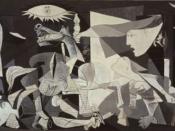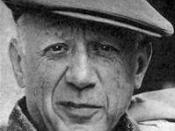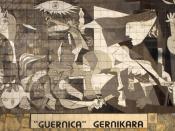Guernica
In 1937, Pablo Picasso painted Guernica, oil on canvas. The Republican Spanish government commissioned the mural for the 1937 World Fair in Paris. Guernica is a large mural, twenty-six feet wide and eleven feet tall, and was placed at the entrance to Spain's pavilion. Picasso did not do any work after receiving the commission until reading of the bombing of the Basque village of Guernica, in Spain. It was that attack, perpetrated by the German Luftwaffe, that inspired him. Guernica, however, is not a complete depiction of that event. In Guernica, Picasso masterfully conveys the suffering of the Basque people and the tragedy of war. He seeks not to report on every detail of the bombing, but only to highlight the suffering by all.
On first viewing Picasso's Guernica, one initially focuses on the center of the mural. Many lines cross or meet near the middle of the work.
There are two major diagonal lines crossing Guernica. They start at the two bottom corners and meet toward the middle-top where the vertex is an oil lamp. These main diagonals are not explicitly defined, but are created with overlapping, dark and light values, and the subjects themselves. For example, towards the bottom right a there is woman picking herself up whose head, neck, and arm point along one of the main diagonals. That diagonal is continued in the background by a contrast between light and dark shapes. These lines frame the middle of the mural, which is further highlighted by some of the lightest values within the work. This area contains a large geometric shape of pure white as part of the background. This light color draws the eye to the center. However, the eye is also drawn to this area because of contrast in light and dark. The black,


